How To Search a Former Homestead Site, page 6
Metal Detecting Technique for Searching a "Virgin" Site with Cellar Hole(s)
(...CONTINUED from Previous Page)

Reverse of a Large Cent
Also examine large trees for signs of unusual growths or indentations. This could be where the tree has grown around nails or rings that once held clothes lines.
Search a straight line between each point and back to the house. People have been washing clothes and hanging them upside down to dry since history of clothing began. When coins, watches and keys were left in pockets, gravity won every time.
If you can, always remove the fallen branches, logs, even modern tires present at the site and detect these spots. Do not be lazy to search under and through bushes and dense vegetation. If you do not do it, someone else will and get rewarded!
Learning to identify bushes such as forsythia, lilac and various roses in their unflowered state will be to your great advantage if you treasure hunt in the Fall months. In the early spring, some of the homestead ground vegetation will be the first vegetation to form green patches easily seen through the leafless forest from a great distance (read more about the homestead vegetation and plants on Atypical and Inherent Vegetation page in my Complete Guide To Metal Detecting Research).

Post-Revolutionary War
Silver Love Charm
Keep an eye out for small neatly arranged stone enclosures in rectangular or circular patterns. Small flower gardens and vegetable patches were favorited by women who often buried their valuables and little treasures in these gardens for quick retrieval. Gold coins, wedding bands, cameos, earrings, love charms and brooches are found at these spots.
Many homes had a driveway off the main road, which led to the horse barn. Search along the driveway and the intersections of pathways.
Many coins and personal items were lost by people at the moment of getting off their horses and, while walking to the house, retrieving the front door keys out of their pockets at the same time in total darkness.
Never leave the segment of main road that runs by the homestead site unsearched! That was where I made a few remarkable finds, both coins and relics, highly sought after by collectors!
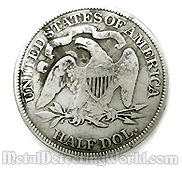
This Half Dollar Was Found on
Road infront of Homestead Site
Two hundred years ago, people tended to throw discarded items out the back door into the yard. The coal ashes also ended here. Apparently they cared less about what neighbors would think because often there were not any!
Clock gears, broken plates, china shards, broken kerosene lamp bases and broken tableware are often found in the back yards. If the house stood until the recent times, you might find a ton of modern junk instead. And getting to the cultural layer of the earlier human occupation would mean removing approximately sixteen inches of soil and refuse.
Wells and outhouses saw constant arrivals and departures. Generally they were a good distance from each other: one usually in the front yard and the other in the back.
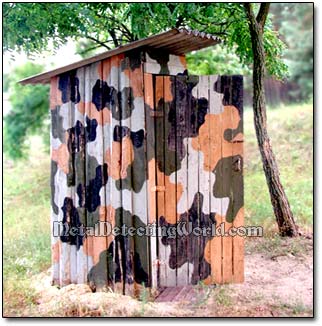
Search the shortest distance between each location and the house. Always be careful not to step into an open well, sometimes hardly visible! Some of the wells are very deep and still intact having a substantial amount of water collected on the bottom.
It is much easier to determine the important locations at the site if it is fenced by the stone walls on its perimeter. The stone walls must be always searched on both sides and thoroughly scanned! Many coin caches have been recovered from underneath the stone fences or in close proximity to them.
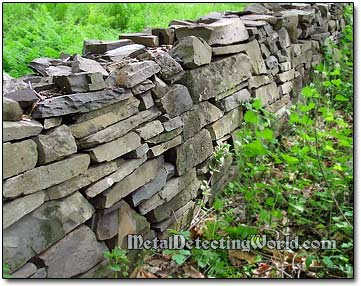
Stone Wall in Ulster County, New York
During the hot summer months, the stone walls also provided shade for a farmer while he was taking breaks during his field work under the merciless sun.
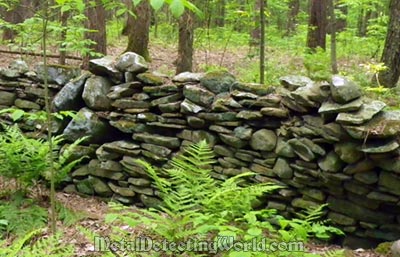
Stone Wall in Montgomery County, New York
Usually there were the wooden rails placed on top of the stone wall, and kids would play on them loosing their pocket collections of old or outdated coins. Or they would hide their "valuables" between the stones. Same goes for the cellar's stone walls in which many valuable finds have been discovered.
Another great spot worth of noting is the bottom point of any descent from the elevated ground situated at the site, or a hill slope in close proximity to the homestead site. During the winter, this elevated ground could be used by kids for sledding down.
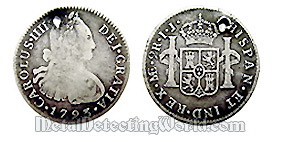
Spanish 1793 2 Silver Reales Carolus IIII
Coins lost in the snow were hard to recover, and in the spring, the downwash of melting snow would bring all coins down to the bottom of a sliding hill. Once, I recovered 5 silver Barber dimes and a Spanish 1793 2-Real silver coin at such a spot which was only four square yards in size!
When a site becomes depleted of good signals, use the search coil of a smaller size and dig up every questionable signal, thus, clearing the area of as many junk targets as possible. Then switch back to a large coil and try to get the deepest coins and relics.
When, at some point, you stop receiving both good and "questionable" signals, consider using the "Scan Deeper Layers" search technique described on page 7 of this article.
When you are sure you hunted this site out, you may want to consider doing additional treasure hunting projects: 1) digging up the outhouse pit and 2) sifting the dirt excavated from the cellar hole's bottom. Many valuables such as rare old bottles, coins, jewelry, etc., could be waiting for your sifter! And always wear gloves!
